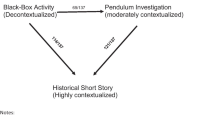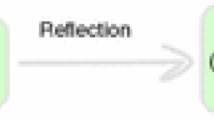Abstract
Analysis of self-reflections of undergraduate education students in a project involving web-supported counterintuitive science demonstrations is reported in this paper. Participating students (N = 19) taught science with counterintuitive demonstrations in local elementary school classrooms and used web-based resources accessed via wireless USB adapters. Student reflections to seven questions were analyzed qualitatively using four components of reflection (meeting objectives/perception of learning, dynamics of pedagogy, special needs accommodations, improving teaching) deriving 27 initial data categories and 12 emergent themes. Overall the undergraduates reported meeting objectives, engaging students in pedagogically relevant learning tasks including, providing accommodations to students with special needs, and gaining practice and insight to improve their own teaching. Additional research is needed to arrive at generalizable findings concerning teaching with web-supported counterintuitive science demonstrations in elementary classrooms.

Similar content being viewed by others
References
A Call to Action: Redefining Teacher Education for Digital Age Learners (n.d.) Available at: http://redefineteachered.org/sites/default/files/SummitReport.pdf?q=summitreport
Balta, N, & Eryilmaz, A (2015) Counterintuitive dynamics test. Intl J of Sci and Math Educ Published online: 06 November (DOI https://doi.org/10.1007/s10763-015-9694-6).
Brewer, W F & Nakamura, G V (1984) The nature and functions of schemas. University of Illinois at Urbana-Champaign, Center for the Study of Reading. Cambridge, Mass..: Bolt Beranek and Newman, Inc.
Dani, D. E., & Koenig, K. M. (2008). Technology and reform-based science education. Theory Into Practice, 47(3), 204–211. https://doi.org/10.1080/00405840802153825.
Everett, L. J., & Pennathur, A. (2007). A design process for conceptually based, counterintuitive problems. Paper presented at the annual conference of the ASEE. Hawaii: Honolulu.
Hofwolt, C A, Kumar, D D, Johnson, J, Carson, S, & Altman, J E (1992–1993) Hyperscience. (An interactive video) Nashville, TN: Vanderbilt University.
Kumar, D. D. (2003). Technology in science teacher education: Discussion of selected applications with insights for research. School Science Review, 84(309), 99–104.
Kumar, D. D. (2004). Analysis of laptop computers in science. Science Education International, 15(3), 201–208.
Kumar, D. D. (2010). Approaches to video anchors in problem-based science learning. Journal of Science Education and Technology, 19(1), 13–19.
Kumar, D D (2014) Counterintuitive science instruction supported with wireless web. A Virtual Presentation at SITE ‘14 Conference, Jacksonville, Florida.
Kumar, D. D. (2017). Teaching counterintuitive science. Primary Science, 148, 33–35.
Lee, G., & Byun, T. (2011). An explanation for the difficulty of leading conceptual change using a counterintuitive demonstration: The relationship between cognitive conflict and responses. Research in Science Education, 42(5), 943–965.
Maylone, N. J. (2000). Using counterintuitive problems to promote student discussions. Mathematics Teaching in the Middle School, 5(8), 542–546.
McCormack, A. J., & Bybee, R. W. (1971). Piaget and the training of elementary science teachers: Theory into practice. Science Education, 55(2), 233–240.
President’s Council of Advisors on Science and Technology. (2010). Report to the President. Prepare and inspire: K-12 education in science, technology, engineering, and math (STEM) for America’s future. Author.
Shapiro, J. R., & Williams, A. M. (2012). The role of stereotype threats in undermining girls’ and women’s performance and interest in STEM fields. Sex Roles, 66, 175–183.
Disclaimer
Views expressed are not that of the funding sources.
Funding
The project reported in this paper was supported in part by a Tech Fee Grant from Florida Atlantic University and 4G WiMax USB adapters and free airtime from FAU/Clearwire Communications of Florida.
Author information
Authors and Affiliations
Corresponding author
Ethics declarations
Ethical Approval
The research reported in this article was subjected to Florida Atlantic University Social, Behavioral and Educational Research Institutional Review Board in accordance with the 1964 Helsinki declaration and its later amendments or comparable ethical standards.
Rights and permissions
About this article
Cite this article
Kumar, D.D., Dunn, J. Self Reflections of Undergraduate Students on Using Web-Supported Counterintuitive Science Demonstrations. J Sci Educ Technol 27, 362–368 (2018). https://doi.org/10.1007/s10956-018-9729-1
Published:
Issue Date:
DOI: https://doi.org/10.1007/s10956-018-9729-1




